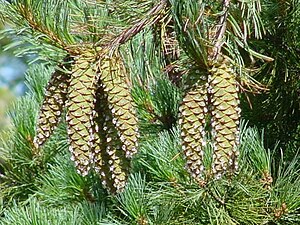Western Weymouth Pine
| Western Weymouth Pine | ||||||||||||
|---|---|---|---|---|---|---|---|---|---|---|---|---|

Western Weymouth Pine needles and cones |
||||||||||||
| Systematics | ||||||||||||
|
||||||||||||
| Scientific name | ||||||||||||
| Pinus monticola | ||||||||||||
| Douglas |
The western Weymouth pine ( Pinus monticola ), also known as the Murray pine , is a species of pine found in the mountains of western North America.
features
The western Weymouth pine regularly reaches a height of 30 to 50 meters and in exceptional cases can reach heights of up to 70 meters. The needles are five in bundles on short shoots. They are five to 13 centimeters long. The cones are between 12 and 32 centimeters long and narrow. When closed, they are between 3 and 4 centimeters wide, when opened they have a diameter of 5 to 8 centimeters. The individual cone scales are thin and flexible. The seeds are small and reach a length between 4 and 7 millimeters.
The western Weymouth pine is closely related to the Weymouth pine from eastern North America. It differs from this species in that it has larger cones and longer-lived needles. It also has a slightly more compact appearance. Important diagnostic features are the shape of the tip of the needles (broad to narrowly pointed, not abruptly pointed to pointed as in the Weymouth pine), the color of the mature scale shields (cream-brown to yellowish, without the purple typical of the Weymouth pine - or shades of gray) and the flat, unlike Weymouth pine, bark of older trees, which is longitudinally cracked. The young shoots are evenly downy-haired and brownish, while in the Weymouth pine they are only hairy under the tufts of needles, are quickly bald and greenish in color.
The number of chromosomes is 2n = 24.
distribution
The main areas of distribution are the Sierra Nevada , the Cascade Range as well as the north-western coastal region and the northern Rocky Mountains . In many regions of its range, such as Oregon and Washington, it occurs at sea level. It is the type of tree that symbolizes the US state of Idaho. The western Weymouth pine is now often planted as an ornamental tree. In their original area of distribution, however, their population has declined sharply due to logging.
Systematics
Pinus monticola was first described in 1832 by David Don in the work of ABLambert, "Descr. Pinus", ed. 3, volume 2, page 144 to. Don included a name that was first used by Douglas. Synonyms are Pinus strobus var. Monticola (Douglas ex D.Don) Nutt. , Pinus porphyrocarpa A. Murray bis or Pinus grozelieri Carrière .
Diseases
The western Weymouth pine is one of the species that is relatively often attacked by straw rust ( Cronartium ribicola ). This mushroom was accidentally introduced from Europe in 1909. It only attacks five-needle pines. The United States Forest Service estimates that 90 percent of the western Weymouth pine population west of the Cascade Range has perished from this fungus. Numerous locations where this pine species originally stood are now covered with other tree species.
Some western Weymouth pines show genetic resistance to straw rust. The US Forest Service is currently running a program to find such resistant trees and to multiply them in a targeted manner.
use
In the western Weymouth pine, white sapwood surrounds a straw-yellow to pale red-brown heartwood in a 2.5 to 7.5 centimeter wide strip . The wood is not very rich in resin. Nevertheless, the resin canals are visible as fine brown lines. The annual rings are not very pronounced and the wood has a very even grain overall. It is a little heavier and harder than the wood of the Weymouth pine. It is mainly used for interior work as joinery and for wall and ceiling coverings, as it is not very durable and difficult to preserve.
swell
Single receipts
- ^ Flora of North America: Pinus .
- ↑ Jost Fitschen (first name), Franz H. Meyer, Ulrich Hecker, Hans Rolf Höster, Fred-Günter Schroeder: Gehölzflora. A book to identify the trees and shrubs that grow wild and are planted in Central Europe. With bud and fruit key , 11th edition, Quelle & Meyer, Wiebelsheim 2002, ISBN 3-4940-1268-7 .
- ^ Tropicos. [1]
- ^ Moore, Gerry; Kershner, Bruce; Craig Tufts; Daniel Mathews; Gil Nelson; Spellenberg, Richard; Thieret, John W .; Terry Purinton; Block, Andrew: National Wildlife Federation Field Guide to Trees of North America . Sterling, New York 2008, ISBN 1-4027-3875-7 , p. 78.
- ↑ a b Rafaël Govaerts (Ed.): Pinus. In: World Checklist of Selected Plant Families (WCSP) - The Board of Trustees of the Royal Botanic Gardens, Kew . Retrieved April 25, 2019.
- ^ US Forest Service Dorena Tree Improvement Center, US Forest Service program for the cultivation of rust-resistant Murray pines
- ↑ Andrew Duncan, Gwen Rigby: The Hobby Carpenters - Technique of Wood Processing , German edition in cooperation with the master school Ebern for the carpentry trade, Orbis Verlag, Munich 1984, ISBN 3-572-00763-1 , p. 195
Web links
- Entry in Flora of North America
- Entry in the Gymnosperm Database
- Pictures at Baumkunde.de
- Pinus monticola inthe IUCN 2013 Red List of Threatened Species . Posted by: Farjon, A., 2013. Retrieved September 3, 2013.

